|
  


Bananas,
sugar, banana leaves, cotton string

1. Rinse the short-grain sticky rice, soak it in
water overnight so that the rice absorbs water and
becomes tasty.
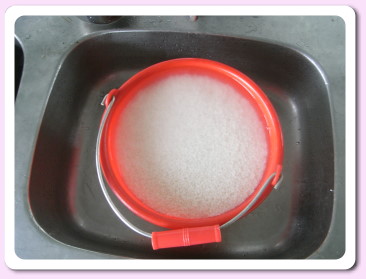
2. Cut the banana leaves into 20 cm squares,
rinse them clean and scrub away any dirt that’s on
the leaves, but be careful not to tear them!
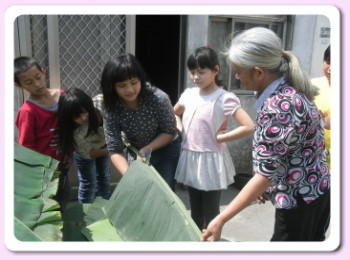 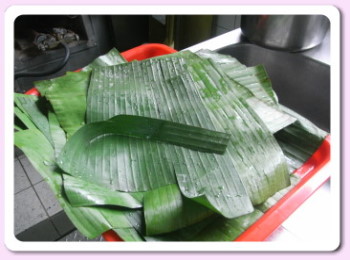
3. Lightly blanch the clean banana leaves in
boiling water, just until they change color, then
remove them from the pot and rinse in cold water. We
asked Ms. Li-lian Wang why the banana leaves had to
be boiled, and she told us that blanched banana
leaves tear less easily when we wrap the inside
them.
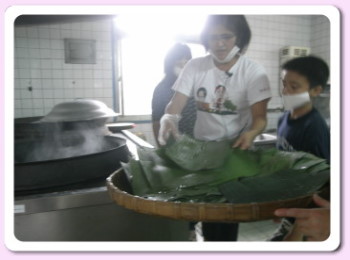 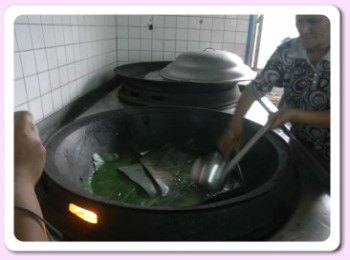
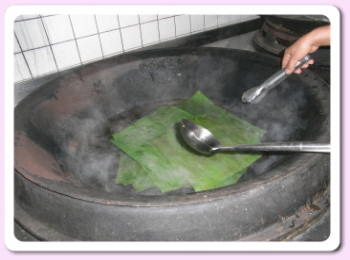
4. Drain the soaked sticky rice dry, add peeled
bananas, sugar, and knead them all together. This is
part that’s most fun, because everyone wanted to try
their hands at it, so the mixture was kneaded
together very quickly. Ms. Li-lian Wang told us, if
we are using 3 liters of rice, then we would need
about 20 bananas. The bananas used in banana rice
should be as ripe as possible so that they provide a
strong banana fragrance.
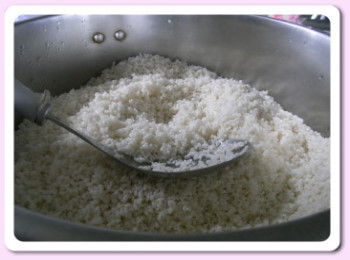 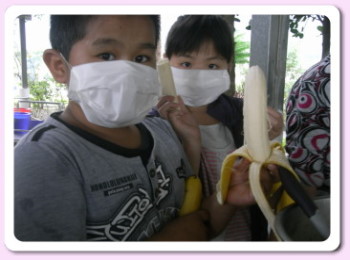
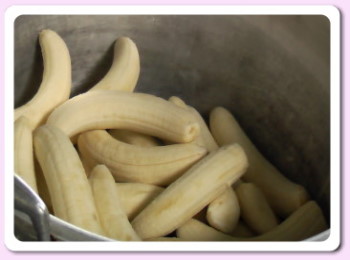 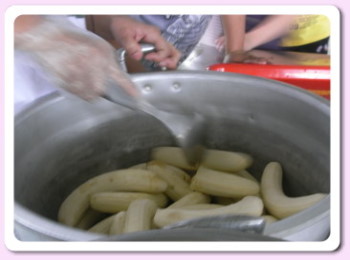
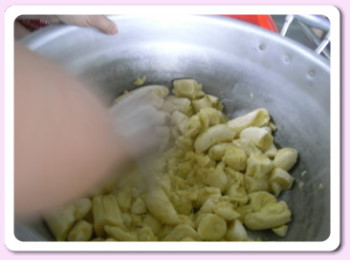 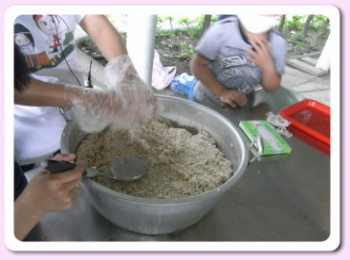
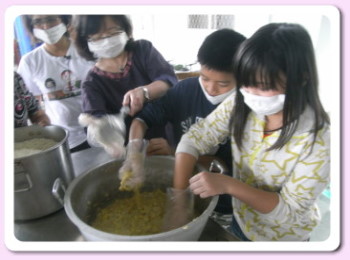
5. Place the banana rice mixture onto the
blanched leaves, roll them into long rolls, and tie
up either end with cotton string. Roll up the rice
along the veins of the banana leaves so that they
tear less easily.
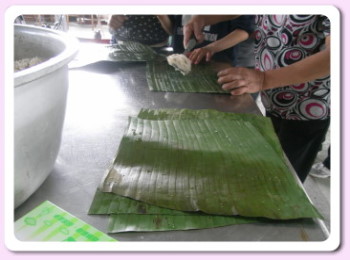 
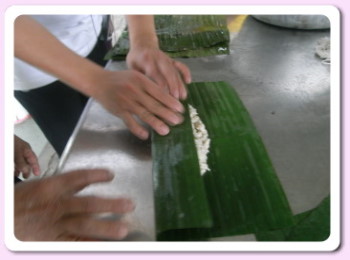 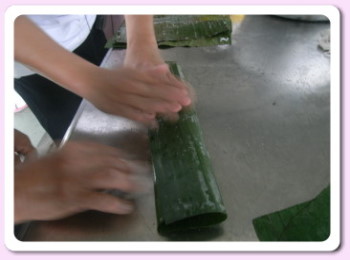
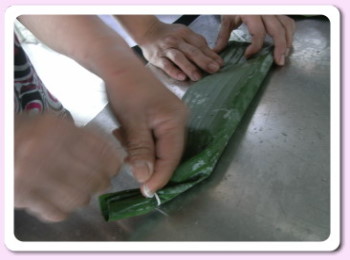 
6. Put the rolls of banana rice in the steamer
for 1 to 2 hours, and it will be ready for eating.
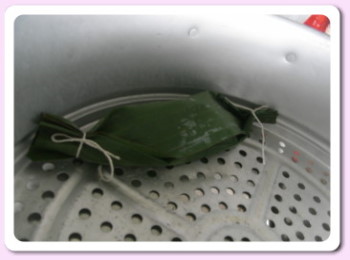 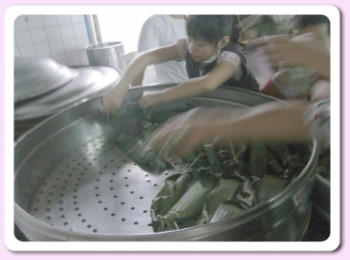
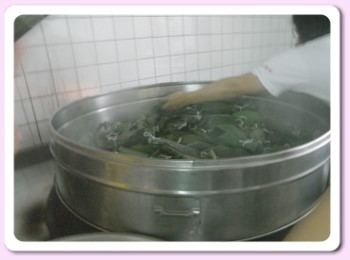 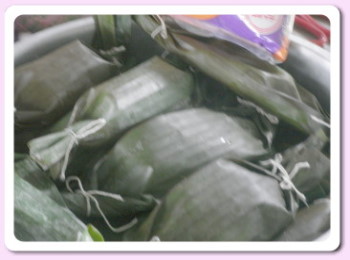
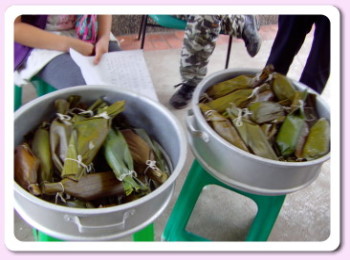 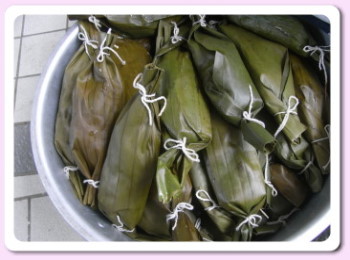
7. There’s a trick to eating banana rice too,
which is simply to remove the string off one end,
then peel away the leaf just as you would peel
banana skin, and the chewy fragrant banana rice is
ready for your enjoyment. Banana rice is great to
eat either hot or cold! [up]
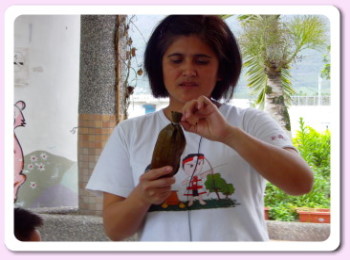

1. How many
liters of rice do you need to make banana rice? What
kind of rice do you use? What preparations have to
be made for the rice?
In terms of liters of rice, it
depends on how many people there are, for example 1
liter of rice would be needed for 10 people.
2. What kind
of sugar is used for banana rice?
We usually use golden sugar for
banana rice, but because people are more aware of
health nowadays, we use brown sugar instead. Brown
sugar is more beneficial to the health as well as
more fragrant. Golden sugar melts more slowly, so it
melds together with the rice and bananas when
cooking; brown sugar, on the other hand, is finer,
and is already melded with the sticky rice and
bananas when all three are mixed together.
3. What do you
have to watch out for when wrapping up the banana
leaves?
Because it is banana rice, we use
banana leaves to enhance the banana fragrance.
Banana leaves must be harvested
the day we’re going to use them, so that they
maintain their freshness. After you bring the leaves
home, cut them into 20cmx20cm squares. Wash them
after you cut them carefully to avoid tearing them,
then boil a pot of water and blanch the leaves.
4. What do you
need to pay attention to when cooking banana rice?
Do you need to season it?
The thing you have to be most
careful about is not tearing the leaves when
wrapping them up, and the second is to use just the
right amount of filling, because too much filling
and the leaves burst, but too little and the
finished product looks unattractive and is
unsatisfying. Determine the amount of filling by the
size of your leaves. When you tie the rolls up, pull
the cotton string tight, or the filling might fall
out during the cooking process.
Banana rice is usually steamed,
watch out so that the water does not exceed the
bottom of the steamer, because if the water touches
the banana rice, then you’re cooking, not steaming
it. The water evaporates in the steaming process, so
you must continue to add water.
In terms of cooking time, start
from when the water boils and you place the banana
rice into the steamer, then put the lid on and cook
for 40 minutes. If you’re making a lot of banana
rice, you must extend the cooking time. When you
arrange the rolls of banana rice in the steamer, do
not place them too closely or tightly together,
because the rice expands when fully cooked, and try
to place them in criss-crossing positions.
Banana rice does not require
seasoning because bananas are already sweet, so be
careful not to add too much sugar in case it becomes
too sweet. Banana rice is fragrant, sweet and has a
great texture, and can be eaten with wild vegetables
or soups. If you want to be creative, you can add
yams or goji berries to the rice and create a unique
flavor.
5. What is the
origin of banana rice?
In the earlier days, when hunters
went hunting, they were often gone for two or three
days at a time, and because the women of Truku
wished their men to eat well even up in the
mountains, they thought of bananas, which are easy
to preserve and high in calorie count, hence
banana+rice=banana rice. This way, the hunters of
the tribe would have no want for food.
6. At what
occasions is banana rice eaten? Are any people not
allowed to eat it?
Because food is nowadays easily
available, banana rice is usually only eaten at
visitor welcoming parties or during thanksgiving
festivities.[up]

|

Yan-rou Wu |
Even though my Payi (meaning
“grandma” in Truku language) would make banana rice
at home, I’ve never really seen her make it, and
it’s great that I learnt how it is done during this
experimental course. |
|
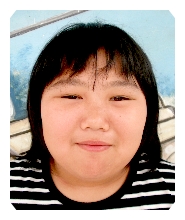
Ting-hsuan
Kao |
When we were making banana rice
today, I observed that everyone really put their
hearts into it, and so the banana rice we made were
all sweet and fragrant, full of the care that we had
put into it. |
|
Ching
Huang |
I thought
this experience of making banana rice was really
special, because I had never done anything like this
when I used to live in Taipei. I really enjoyed the
cooking process today, and hope to teach my children
how to make banana rice when I grow up.[up] |

Reference:
1. 2011.4.5,
Sinbaiyang Cultural Information Club Experimental
Course Process (Bamboo Rice)
2.
Jianching Village, Wanrong
Township, Hualien County. Interviewee:
Ms. Bao-shu Hen ,
Date of Interview: 2011.5.26 |

